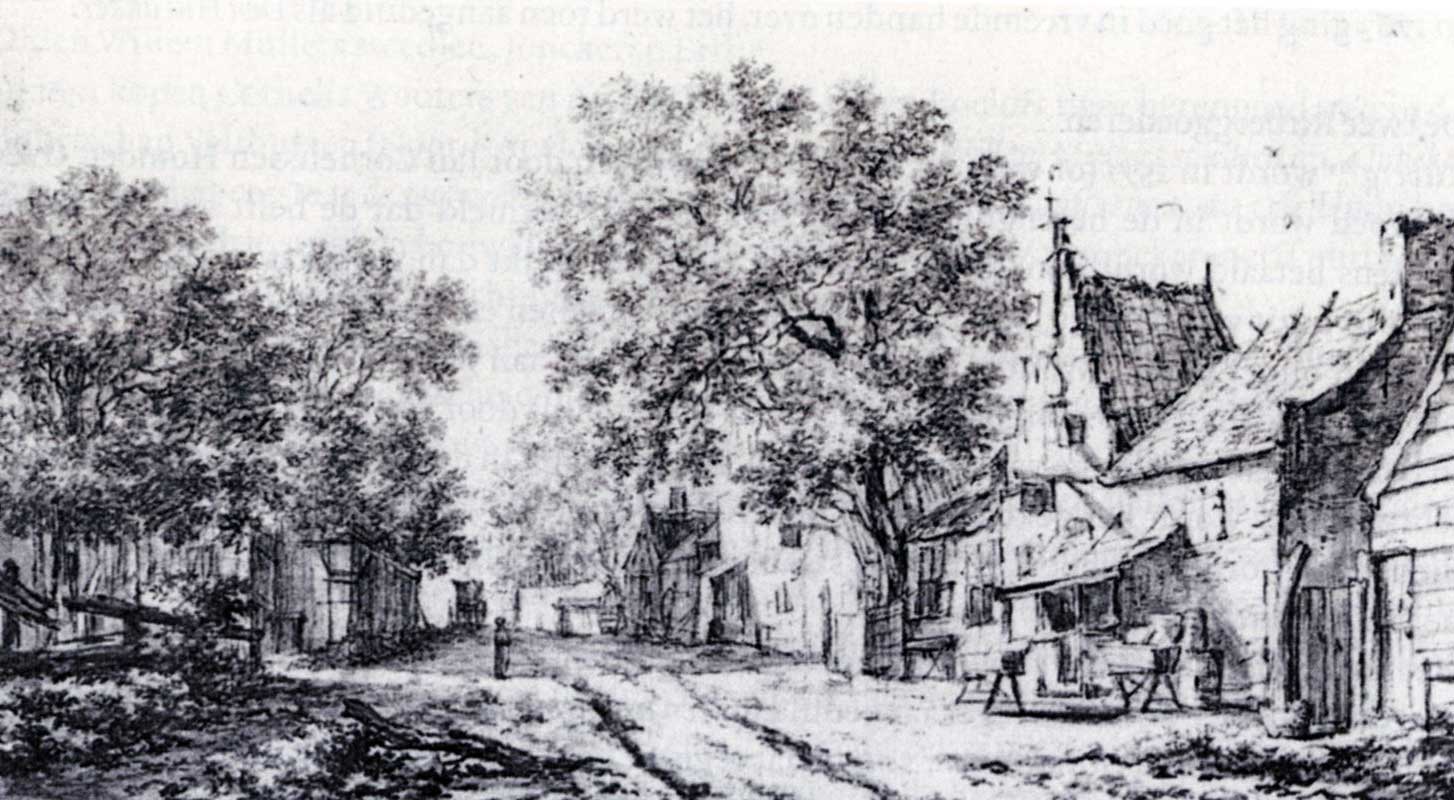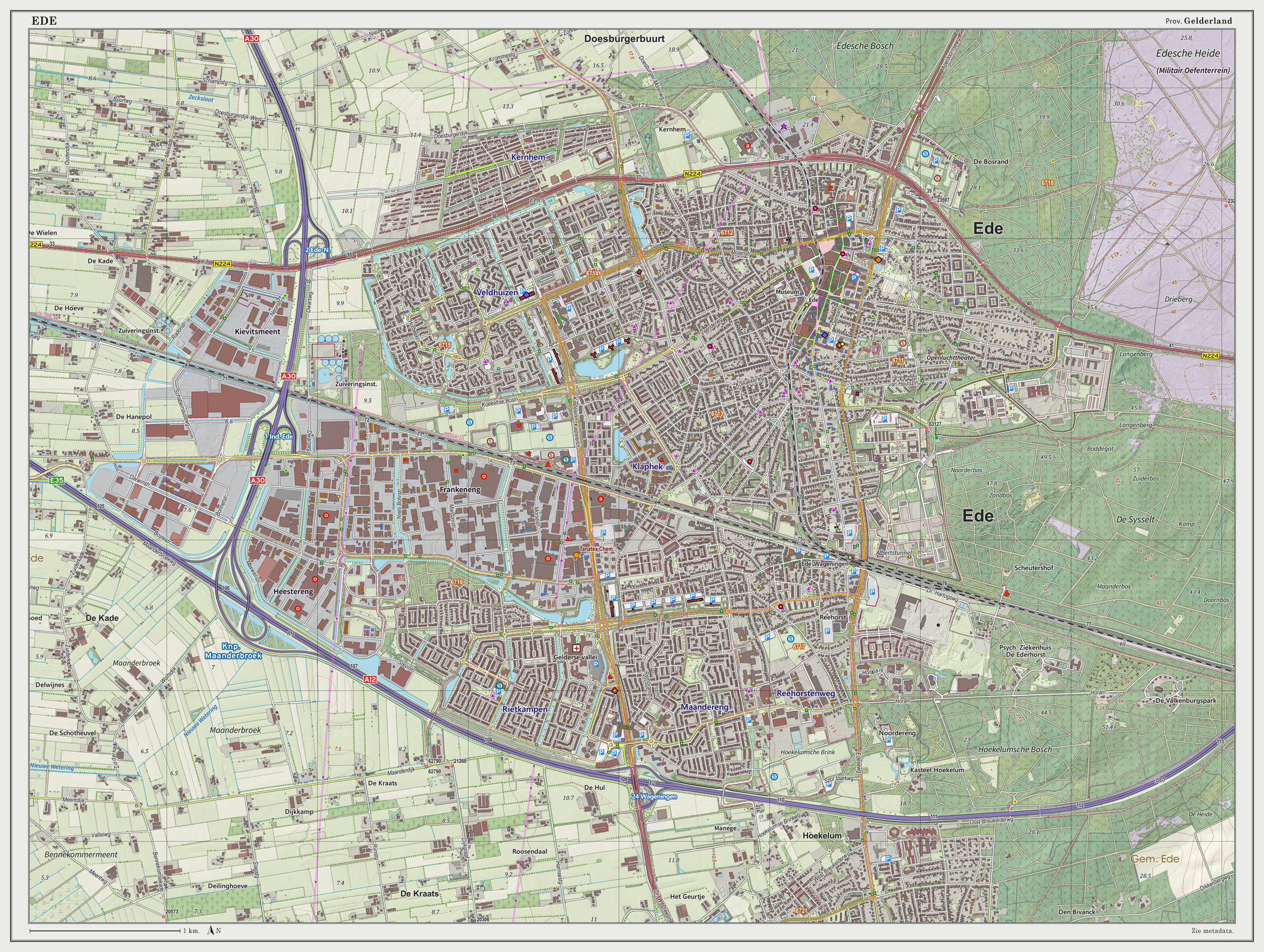|
Hoenderloo
Hoenderloo () is a Dutch village located south west of the city of Apeldoorn. Most of the village is part of the municipality of Apeldoorn, but a small part belongs to the municipality of Ede, among which the hamlet . The village is located in the Southern part of the Veluwe and close to the national park Hoge Veluwe and the Deelerwoud. It is a very touristic village, with a large number of camping sites, recreation parks, restaurants, hotels and shops. History It was first mentioned in 1748 as "Hoender Lo Struycken", and means forest with galliformes. In 1813, the shephard Albert Brinkenberg becomes the first official resident. In 1840, there were 24 sod houses at the site. In 1841, during his travels the vicar Ottho Heldring stumbled upon the remote village and decided to invest in the village by building a well, a school in 1846 and a church in 1858. In 1848, a predecessor of the current Hoenderloo Group, at that time an institution for underprivileged boys, was founded ... [...More Info...] [...Related Items...] OR: [Wikipedia] [Google] [Baidu] |
Ottho Gerhard Heldring
Ottho Gerhard Heldring (17 May 1804 – 11 July 1876) was a Dutch preacher and philanthropist who believed in justification through faith but also in social work. He was one of the early leaders of the Dutch temperance movement. He is known for establishing homes and schools for prostitutes wishing to start a new life and for vulnerable girls and young women. Early years Ottho Gerhard Heldring was born on 17 May 1804 at Zevenaar, the third son of Reverend Ottho Gerhard Heldring (1762–1841) and Louisa Geertruida Janssen (1764–1840). Heldring grew up in a pietist family environment. He went to Utrecht to study theology when he was sixteen, but was deeply disturbed by the humanistic and rationalistic theology he was exposed to there, and abandoned his studies after a spiritual crisis. He worked on the land for a period, then at his father's request became a pastor. He was admitted to this profession by the Hemmen municipality and confirmed on 25 March 1827. He would remain in this ... [...More Info...] [...Related Items...] OR: [Wikipedia] [Google] [Baidu] |
Apeldoorn
Apeldoorn (; Dutch Low Saxon: ) is a municipality and city in the province of Gelderland in the centre of the Netherlands. It is located about 60 km east of Utrecht, 60 km west of Enschede, 25 km north of Arnhem and 35 km south of Zwolle. The municipality of Apeldoorn, including villages like Beekbergen, Loenen (Apeldoorn), Loenen, Ugchelen and Hoenderloo, had a population of 165,525 on 1 December 2021. The western half of the municipality lies on the Veluwe ridge, with the eastern half in the IJssel valley. The city of Apeldoorn The oldest known reference to Apeldoorn, then called Appoldro, dates from the 8th century. The settlement came into being at the point where the old road from Amersfoort to Deventer crossed that from Arnhem to Zwolle. A 1740 map refers to it as A''pp''eldoorn.Stenvert, R. et al. (2000). ''Monumenten in Nederland: Gelderland'', p. 14 and 68–77. Zwolle: Waanders Uitgevers. Close by is the favourite country-seat of the royal family of the Ne ... [...More Info...] [...Related Items...] OR: [Wikipedia] [Google] [Baidu] |
Ede, Netherlands
Ede () is a Municipalities of the Netherlands, municipality and a town in the centre of the Netherlands, in the province of Gelderland. Ede had 119,186 inhabitants. Population centres Community: * Bennekom * De Klomp * Deelen * Ede (town) * Ederveen * Harskamp * Hoenderloo * Lunteren * Otterlo (Kröller-Müller Museum) * Wekerom The village of Ede Location The village itself is situated halfway between the larger cities of Arnhem and Utrecht (city), Utrecht, with direct rail and road connections to both cities. There are no connections to any water nearby; however, there also is a direct road connection to the city of Wageningen which hosts a small industrial port on the river Rijn and a direct road and rail connection to the city of Arnhem, which features a larger port at a greater distance. The environment is clean and green due to the fact that Ede is partly built in a forest and partly on the central Dutch plains in the national park called Nationaal Park De Hoge Vel ... [...More Info...] [...Related Items...] OR: [Wikipedia] [Google] [Baidu] |
Marskramerpad
The E11 European long distance path or E11 path is one of the European long-distance paths, running 4700 km (about 2900 miles) west-east from The Hague in the Netherlands through Germany, Poland, Lithuania, Latvia to Tallinn, Estonia. It starts in Scheveningen, a fishing community, commercial harbor and spa in The Hague on the Dutch coast of the North Sea. It ends in Tallinn, a medieval Hanseatic town situated side by side with the 21st century city of modern glass buildings, located on the shore of the Gulf of Finland of the Baltic Sea. The E11 is one of three European long distance paths running East from the Benelux to the Baltic states. In the North, following the German, Polish, Lithuanian, Latvian and Estonian coasts of North Sea and Baltic Sea, the E9 offers a variety of polders, sandy and rocky beaches, dunes, coastal meadows and commercial harbors. In Estonia the route goes along the very seashore for around 100 km, mainly between Haapsalu and Tallinn. But ... [...More Info...] [...Related Items...] OR: [Wikipedia] [Google] [Baidu] |
Hoge Veluwe National Park
De Hoge Veluwe National Park (, "The High Veluwe") is a Dutch national park in the province of Gelderland near the cities of Ede, Wageningen, Arnhem and Apeldoorn. It is approximately in area, consisting of heathlands, sand dunes, and woodlands. It is situated in the Veluwe, the area of the largest terminal moraine in the Netherlands. Most of the landscape of the park and the Veluwe was created during the last ice age. The alternating sand dune areas and heathlands may have been caused by human utilization of the surrounding lands. The park forms one of the largest continuous nature reserves in the Netherlands. History The park was established by the businessman Anton Kröller and his wife Helene Kröller-Müller as a private estate in 1909. Up until 1923 the park was under construction with wildlife being imported and the building of the hunting lodge and fences. The hunting residence is called ''St. Hubertus Hunting Lodge'' after St. Hubertus and was designed by prominent D ... [...More Info...] [...Related Items...] OR: [Wikipedia] [Google] [Baidu] |
Village
A village is a clustered human settlement or community, larger than a hamlet but smaller than a town (although the word is often used to describe both hamlets and smaller towns), with a population typically ranging from a few hundred to a few thousand. Though villages are often located in rural areas, the term urban village is also applied to certain urban neighborhoods. Villages are normally permanent, with fixed dwellings; however, transient villages can occur. Further, the dwellings of a village are fairly close to one another, not scattered broadly over the landscape, as a dispersed settlement. In the past, villages were a usual form of community for societies that practice subsistence agriculture, and also for some non-agricultural societies. In Great Britain, a hamlet earned the right to be called a village when it built a church. [...More Info...] [...Related Items...] OR: [Wikipedia] [Google] [Baidu] |
Hendrik Petrus Berlage
Hendrik Petrus Berlage (21 February 1856 – 12 August 1934) was a Dutch architect. He is considered one of the fathers of the architecture of the Amsterdam School. Life and work Hendrik Petrus Berlage, son of Nicolaas Willem Berlage and Anna Catharina Bosscha, was born on 21 February 1856 in Amsterdam in the Netherlands. Anna Catharina Bosscha's uncle was Johannes Bosscha, a scientist who taught in Polytechnische School te Delft. Berlage studied architecture at the ETH Zurich, Zurich Institute of Technology between 1875 and 1878 after which he traveled extensively for 3 years through Europe. In the 1880s he formed a partnership in the Netherlands with Theodore Sanders which produced a mixture of practical and utopian projects. A published author, Berlage held memberships in various architectural societies including Congrès International d'Architecture Moderne, CIAM I. Berlage was influenced by the Neo-Romanesque brickwork architecture of Henry Hobson Richardson and of the ... [...More Info...] [...Related Items...] OR: [Wikipedia] [Google] [Baidu] |
Hiking Route E11
Hiking is a long, vigorous walk, usually on trails or footpaths in the countryside. Walking for pleasure developed in Europe during the eighteenth century.AMATO, JOSEPH A. "Mind over Foot: Romantic Walking and Rambling." In ''On Foot: A History of Walking'', 101-24. NYU Press, 2004. Accessed March 1, 2021. http://www.jstor.org/stable/j.ctt9qg056.7. Religious pilgrimages have existed much longer but they involve walking long distances for a spiritual purpose associated with specific religions. "Hiking" is the preferred term in Canada and the United States; the term "walking" is used in these regions for shorter, particularly urban walks. In the United Kingdom and the Republic of Ireland, the word "walking" describes all forms of walking, whether it is a walk in the park or backpacking in the Alps. The word hiking is also often used in the UK, along with rambling , hillwalking, and fell walking (a term mostly used for hillwalking in northern England). The term bushwalking is ende ... [...More Info...] [...Related Items...] OR: [Wikipedia] [Google] [Baidu] |






